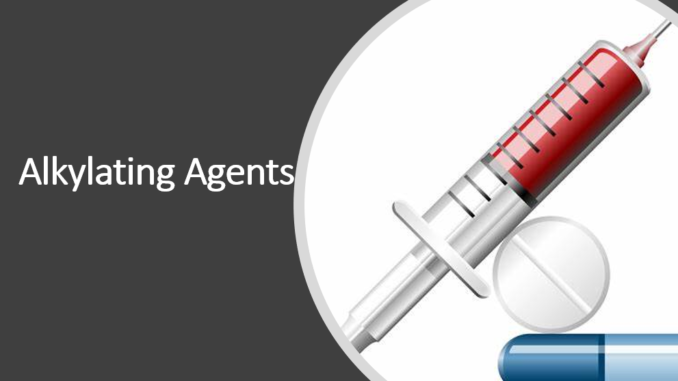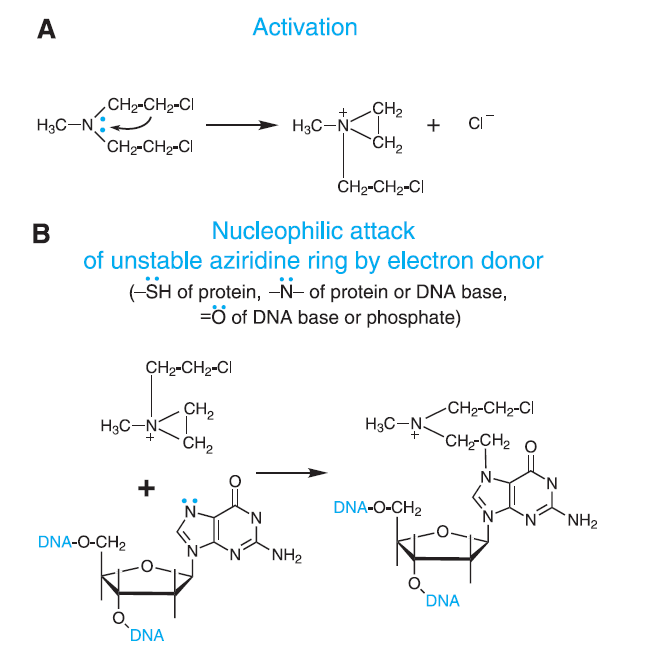
- Alkylating agents are among the oldest and useful anti-neoplastic drugs. They are cytotoxic drugs and hence, act directly on cells.
- Before introduction of alkylating agents in medicinal field, they were used as chemical warfare. The pharmacological properties of nitrogen mustard- 1st alkylating agents to be used medicinally, was known only after end of World War II. Goodman and Gillman and their colleagues initiated clinical study of nitrogen mustard in lymphoma patients in 1942. It was the launch of modern era of cancer chemotherapy.
- Five major types of alkylating agents used in chemotherapy are:
- Nitrogen mustard- Examples include cyclophosphamide, isofosfamide, mechlorethamine.
- Alkyl sulfonate- e.g. Busulfan
- Nitrosoureas– e.g. Carmustine, lomustine
- Ethyleneimines- e.g. Thiotepa
- Triazenes– e.g. Dacarbazine, temozolamide.
- Methylhydrazine and platinum complex, though don’t alkylate DNA, are included in this list.
Mechanism of action of Alkylating agents

Figure 1- Mechanism of action of Alkylating Agents (Source- Goodman and Gillman Book)
- Alkylating agents form highly reactive quaternary ammonium derivatives (ethyleneimine cations). These intermediates covalently bind to groups like amino, phosphate and sulfhydryl of DNA bases. Alkylation of these bases make them unavailable for synthesis of DNA.
- Alkylation also lead to mispairing and repair causing breakage of DNA strand. Most common binding site of alkylating agent is 7 nitrogen group of guanines. Guanosine (keto-tautomer) normally makes H-bonding with cytosine. When alkylated in 7th position, it (enol-tautomer) can mispair with thymine. N7 alkylation also lead to opening and excision of the imidazoline ring. Hence, mispairing and imidazoline ring opening lead to attempt to repair and hence breakage of strand. Bifunctional alkylating agent can cause crosslinking of DNA or with proteins and interfere with cell replication.
- Platinum complex drugs like cisplatin are prototype drug. They enter cells and are converted into active form which bind with nucleophilic sites of DNA and proteins. The cytotoxic lesion formed inhibit both DNA replication and RNA synthesis.
- All alkylating agents are cell cycle phase non-specific drugs. They can damage DNA during any phase of cell cycle. However, their effect is more seen in rapidly proliferating cells.
Mechanism of resistance to alkylating agents
- When alkylating agents are used as single therapeutic agents, chances of resistance may occur. The resistance may develop due to following reasons:
- Decreased permeation of drugs into cells.
- Increased activity of DNA repair pathways. The repair pathways may differ according to the alkylating agents used.
- Increase in rate of metabolism of active forms of drug like cyclophosphamide and ifosfamide.
- Increased intracellular concentration of nucleophilic substance like glutathione which can conjugate and neutralize electrophilic intermediates.
Indications
- They are most widely used anti-cancer drugs and are major component of combination therapy. Each alkylating agents has their own use.
- They are used to treat different kind of cancer including:
- Breast cancer.
- Acute and chronic lymphoblastic leukemia.
- Brain tumor.
- Ovarian cancer.
- Testicular cancer.
- Bladder cancer.
- Colon cancer.
- Osteosarcoma.
- Hodgkin’s and non-hodgkin’s lymphoma.
- Soft tissue sarcoma.
Toxicities
Bone Marrow toxicity
- As they damage nuclei of dividing and growing cells, hemopoietic system is more susceptible to side effects. They can cause leucopenia, anemia and thrombocytopenia. The extent of action of each alkylating agents differ from each other. Chlorambucil has more effect on lymphoid cells whereas busulfan is more effective against myeloid tissue.
Mucosal toxicity
- They exert toxic effect on dividing mucosal cells and cause oral mucosal ulceration and intestinal denudation. Cyclophosphamide, thiotepa and melphalan cause less mucosal damage compared to other agents.
Neurotoxicity
- IV administration of alkylating agents cause CNS effects like nausea and vomiting. Ifosfamide is most neurotoxic agents and cause cerebellar ataxia, coma and generalized seizures. High dose of busulfan may cause seizures.
Immunosuppression
- They suppress antibody production and act as immunosuppressant. Hence, they increase chances of opportunistic infections.
Others
- They damage hair follicles and cause alopecia. They can cause impairment of spermatogenesis in male which is irreversible. In female, they can cause amenorrhea and fetotoxicity.
References
- Pharmacology and Pharmacotherapeutics. 24th edition.
- Goodman and Gillman Manual of Pharmacology and Therapeutics.
- Lippincott Illustrated Reviews Pharmacology, 6th edition.
- https://www.ncbi.nlm.nih.gov/books/NBK564367/